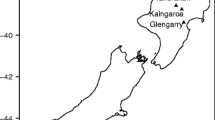Abstract
Twelve, 16-ha study sites were established in recently harvested (1980) stands of natural pine-mixed hardwoods located in the Piedmonts of South Carolina and Georgia. Treatments applied were check (no site preparation), herbicide-burn (3.4 kg ae Glyphosate/ha), chop-burn, shear-disc, shear-V blade-disc, shear-pile, and shear-pile-disc. Measurements collected after two growing seasons included pine height, diameter, and occurrence of pine tip moth (Rhyacionia spp.) infestation on the terminal shoot. After the second growing season, tree volume was 58% greater on mechanically-treated areas compared to the check and herbicide-burn areas. Average pine tip moth incidence was 15% for the check treatment and ranged from 24 to 36% for the other six treatments. Although the disced treatments had higher tip moth infestation (32 to 36%) compared to the check plots (15%), pine growth was significantly greater for treatments involving discing.
Similar content being viewed by others
References
Balmer, W. E., Williston, H. L., Dissmeyer, G. E. and Pierce, C. 1976. Techniques and advantages of site preparation in reforestation. For. Farmer 36 (2): 9–10, 35–39.
Beal, J. A., Haliburton, W. and Knight, F. B. 1952. Forest insects of the Southeast: with special reference to species occurring in the Piedmont Plateau of North Carolina. Duke Univ. School of Forestry, Durham, NC. Bull. 14. 168p.
Berisford, C. W. and Kulman, H. M. 1967. Infestation rate and damage by the Nantucket pine tip moth in six loblolly pine stand categories. For. Sci. 13: 428–438.
Campbell, R. G. 1973. The impact of timber harvesting and site preparation on selected soil conditions and plant growth. Ph.D. dissertation, Univ. of Georgia, Athens, GA. 65p.
Canalos, C. G. 1982. Interaction of herbaceous weed and Nantucket pine tip moth control in loblolly pine plantations. M.S. Thesis, Univ. of Georgia, Athens, GA. 48p.
Coile, T. S. and Schumacher, F. X. 1953. Site index of young stands of loblolly and shortleaf pines in the Piedmont Plateau region. J. For. 51: 432–435.
Haywood, J. D., Thill, R. E. and Burton, J. D. 1981. Intensive site preparation affects loblolly pine growth on upland sites. pp. 224–231. In: Forest Regeneration. ASAE Pub. 10–81.
Henry, B. W. and Hepting, G. H. 1957. Pest occurrences in 35 of the southwide pine seed source study plantations during the first three years. USDA Forest Service, So. and SE Forest Exp. Stations, New Orleans, LA. 7p.
Hertel, G. D. and Benjamin, D. M. 1977. Intensity of site preparation influences on pine webworm and tip moth infestations of pine seedlings in North-central Florida. Environ. Entom. 6: 118–122.
Holst, M. 1963. Breeding resistance in pines to Rhyacionia moths. FAO World Consult. For. Genet., Stockholm, No. FAO/FORGEN 63/-6b/3, 17p.
Lashomb, J. H., Steinhauer, A. L. and Douglass, L. 1978. Impact studies of Nantucket pine tip moth populations on loblolly pine. Environ. Entom. 7: 910–912.
Nelson, L. R. and Cade, S. C. 1984. Integrated pest management in pine stands (0–5 yrs.) -Vegetation, pp. 72–87. In: Hertel, G. D. and Branham, S. J. (Eds) Proceedings, Integrated Forest Pest Management Symposium. Univ. of Georgia Center for Continuing Education, Athens, GA. 281p.
Pehl, C. E. and Bailey, R. L. 1983. Performance to age ten of a loblolly pine plantation on an intensively prepared site in the Georgia Piedmont. For. Sci. 29: 96–102.
Pritchet, W. L. 1981. Site reparation in the coastal flatwoods. Sch. of For. Resour. and Conserv., Univ. of Florida, Gainesville. IMPAC Report 6 (7). 21p.
Ruehle, J. L., Marx, D. H. and Muse, H. D. 1984. Calculated nondestructive indices of growth response for young pine seedlings. For. Sci. 30: 469–474.
Smith, R. L. 1974. Ecology and field biology. Harper and Row, New York. 850p.
Sokal, R. R. and Rohlf, F. J. 1969. Biometry. W. H. Freeman and Company, San Francisco, California. 776p.
Thomas, H. A. and Oprean, C. P. 1984. Growth impact of tip moth control in 23 year-old pines. USDA Forest Service, SE For. Exp. Sta., Asheville, NC., Res. Note SE-324. 7p.
Thomas, H. A., Miller, T. and McNab, W. H. 1982. Pine tip moth damage in relation to site preparation and regeneration method for loblolly pine. USDA Forest Service, SE Forest Exp. Sta., Asheville, NC. Res. Note SE-311. 3p.
Warren, L. O. 1964. Growth of pine trees protected from attack by Nantucket pine tip moth. Ark. Agric. Exp. Sta., Fayetteville, AR, Farm Research Jan–Feb. 11p.
Williston, H. L. and Barras, S. J. 1977. Impact of tip moth injury on growth and yield of 16-year old loblolly and shortleaf pine. USDA Forest Service, SO Forest Exp. Sta., New Orleans, LA., Res. note SO-221. 6p.
Yates, H. O. 1960. The Nantucket pine moth, a literature review. USDA Forest Service, SE Forest Exp. Sta., Asheville, NC., Sta. Paper 115. 19p.
Yates, H. O. 1966. Susceptibility of loblolly and slash pines to Rhyacionia spp. oviposition, injury, and damage. J. Econ. Entomol. 59, 1461–1964.
Author information
Authors and Affiliations
Rights and permissions
About this article
Cite this article
Lantagne, D.O., Burger, J.A. Effect of site preparation intensity on the early growth of loblolly pine (Pinus taeda L.) and the incidence of pine tip moth (Rhyacionia spp.). New Forest 2, 219–229 (1988). https://doi.org/10.1007/BF00027938
Received:
Accepted:
Issue Date:
DOI: https://doi.org/10.1007/BF00027938




